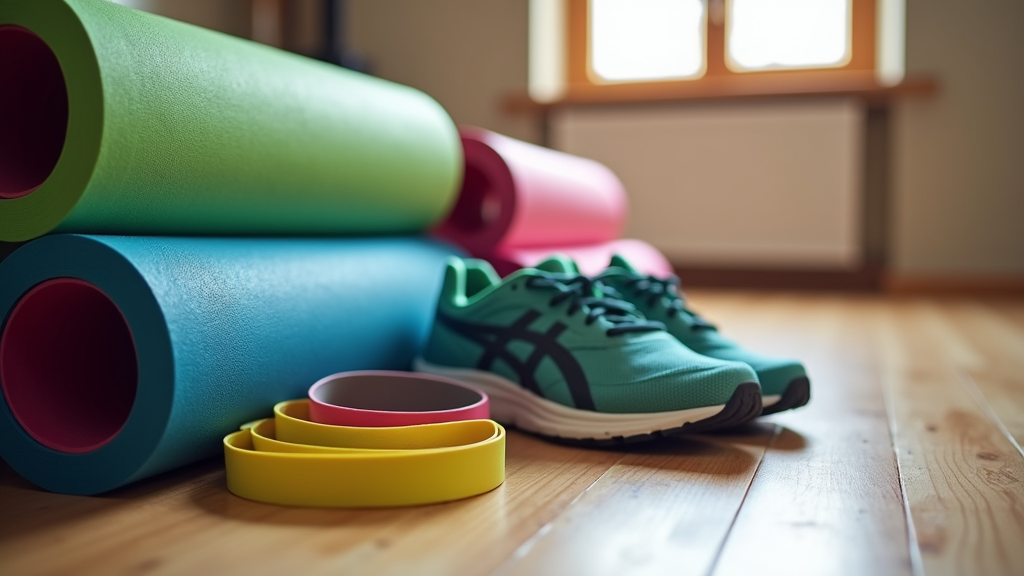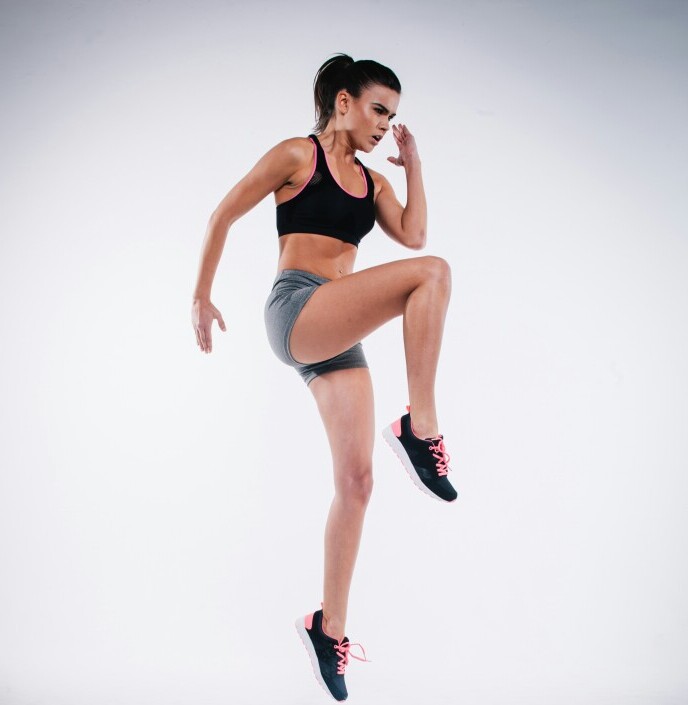I love running and I have been doing it for years, it boosts my mood and keeps my body in shape, but it can also come with some unwelcome side effects. One of the most common is muscle soreness. Everyone has soreness when they first take up running – I did. I’ve spent a lot of time learning about how the body reacts after a run and easing sore muscles. understanding what causes muscle soreness and how to manage it can make your running routine much more enjoyable. Let’s dive in.

Understanding Muscle Soreness After Running
During exertion, a lot of chemical reactions occur in your muscle cells. All these chemical reactions accumulate products and by-products which cause water to enter into the cells. That causes the pressure inside and between muscle cells to increase. This pressure, combined with the movement of molecules from the muscle cells can stimulate nerve endings and cause discomfort during exercise.
The pain and discomfort you sometimes feel hours to days after an unfamiliar type or amount of exercise has a different list of causes. When you run, your muscles work hard to propel you forward, which can lead to microscopic damage to your muscles and their connections to tendons. Such damage causes the release of ions and other molecules from the muscles, causing localized swelling and stimulation of nerve endings. This is sometimes known as “delayed onset muscle soreness” or DOMS.
While the damage occurs during the exercise, the resulting response to the injury builds over the next one to two days (longer if the damage is severe). This can sometimes cause pain and difficulty with normal movement. This delayed onset muscle soreness is a natural part of the exercise process.
DOMS typically appears a day or two after intense exercise and is a sign that your muscles are repairing themselves. Overstraining or not allowing enough time for repair and recovery can lead to more severe discomfort. Recognizing these signals helps you adjust your training so that each run leaves you feeling stronger and better prepared for the next run.
Many runners wonder which muscles should feel the impact after a run. Typically, you might notice some tightness in your calves, quads, hamstrings, and sometimes your glutes and lower back. These are the primary muscles engaged during running.
Preparing Your Body: Warm-Up and Cool-Down Routines
One of the best ways to help reduce muscle soreness is by properly preparing your body before and after running with a good warm-up. When I get ready for a run, I usually start with some light jogging and dynamic stretches. This helps increase blood flow to my muscles and gradually raises my heart rate, reducing the risk of injuries.

Dynamic stretches like high knees, leg swings, and butt kicks are particularly helpful. These movements mimic the running action and stimulate your muscles to work efficiently. A warm-up that lasts about 10 minutes can make a big difference in preventing excessive soreness later.
Cooling down after a run is equally important. I always take at least five to ten minutes to bring my heart and respiratory rate down with a slow walk and static stretching. Static stretches, which involve holding a stretch for 20-30 seconds, help relax tight muscles and can reduce the intensity of DOMS.
Incorporating foam rolling as part of your cool-down routine can also be really beneficial. The gentle pressure from the foam roller helps release muscle knots and increase circulation. See my article on warming up.
Should I Run Through Muscle Soreness?
We’ve all heard the “No Pain, No Gain” mantra. If the soreness is mild and feels like the usual post-run stiffness, a light run, or an easy jog might help stimulate blood flow and speed up recovery. However, if you’re dealing with significant pain, it’s generally better to take a day off and let your body recover.
Running through severe soreness is not advisable. Finding the balance between staying active and giving your muscles the rest they need is really the key to maintaining an exercise routine for long-term health and fitness. A recovery run at a much slower pace on less challenging terrain, or just walking can sometimes be enough to keep your body moving while it repairs tissue without overloading your muscles.
Techniques to Soothe Sore Muscles After a Workout
I find getting involved in active recovery is very effective. Instead of completely stopping all activity, try low-intensity exercises like walking, cycling, or even gentle yoga. These activities keep blood circulating, which helps blood flow to your muscles and reduce stiffness.
Another method that has worked well for me is foam rolling. This simple tool can be used to apply pressure to tight muscles, reducing knots and promoting better circulation. Spending around 10-15 minutes rolling out your legs can make a noticeable difference in how your muscles feel the next day.
Cold therapy, such as applying ice packs to particularly sore areas, can help reduce inflammation. Conversely, a warm bath or a heating pad might provide relief by relaxing tense muscles. Many runners find alternating between cold and warm treatments to be quite effective. And it feels great.
Nutrition remains a pillar of recovery. Making sure you get enough protein helps repair muscle tissue, while carbohydrates replenish the energy stores depleted during your runs. It is really important to mix in a variety of nutrient-dense foods. For example, consuming antioxidant-rich berries, leafy greens, and lean proteins can help repair and build muscle tissue after intense runs.
Continually hydrating throughout the day—not just around your workout—ensures that your muscles receive the minerals and fluids they need to function optimally. Experiment with timing your meals and snacks to see what gives your energy levels the best boost.
Advanced Tips for Faster Recovery
Once you have the basics covered, you might be interested in some advanced strategies to speed up muscle recovery. One aspect that I’ve found really useful is planning my training schedule with muscle recovery in mind. Mixing high intensity running days with easier recovery days allows my muscles to recuperate better, reducing the chances of severe soreness.
Sleep is another area that should never be overlooked. During sleep, your body undergoes repair and regeneration. A good night’s sleep can definitely take muscle recovery up a notch. I always aim for at least 7-8 hours of sleep.
Using anti-inflammatory supplements is something some runners explore. While it’s important to consult with a healthcare professional before adding any supplement to your routine, supplements like omega-3 fatty acids, turmeric, magnesium, and vitamin D can support muscle health and recovery.
Listening to your body’s signals is probably the most advanced tip of all. Even with a well-structured plan, if your body is telling you it needs rest, it’s smart to heed that signal. Scheduling active recovery days and paying attention to your body’s feedback can help prevent injuries and long-term damage.

Consider incorporating activities that build strength and flexibility over time. Regular strength training sessions can help stabilize your joints and reduce the risk of repetitive injuries. Adding core exercises, balance drills, and leg strengthening routines not only smooth the way for better running performance but also help you get a feel for your body’s limits.
Mental recovery is just as significant as physical recovery. Setting aside time for meditation or simple deep breathing exercises can help lower stress levels, which in turn supports faster muscle repair and better sleep patterns. Over time, these practices help create a balanced routine where physical exertion and mental relaxation work together to keep you in peak form.
Final Thoughts and Next Steps
Muscle soreness after running is a natural part of the training process and understanding it can really help you manage your workout routine more effectively. By incorporating proper warm-up and cool-down routines, listening to your body when it signals that it needs a break, and using recovery techniques like foam rolling and active recovery, you can significantly decrease muscle soreness and enjoy a smoother running experience.
Keep in mind that ongoing learning and attentive self-care are important parts of any training routine. Whether you choose to take a gentle recovery run or spend some extra time on stretching and foam rolling, these practices help you maintain your running habits while reducing discomfort.
Running offers many benefits for your overall health and mental well-being, so finding a balance that allows you to run regularly without sidelining you due to soreness is very important. Over time, with proper strategies in place, your body will adapt, and recovery will become more efficient, making it easier to enjoy each run. Here’s to many more runs that are not only enjoyable but also kind to your muscles!


Hi Kevin,
I read your article “How To Prevent Muscle Soreness After Running” and found it incredibly informative and well-written. As a fellow runner, I can definitely relate to the challenges of dealing with muscle soreness, especially when first starting out or increasing mileage.
Your tips on proper warm-up and cool-down routines, active recovery, foam rolling, and nutrition are spot-on. I particularly appreciate how you emphasized the importance of listening to your body’s signals and finding a balance between pushing yourself and allowing adequate rest and recovery.
One thing I’ve found helpful in managing muscle soreness is incorporating regular yoga sessions into my routine. The stretching and breathing exercises seem to complement my running nicely, helping to improve flexibility and reduce overall tension. Have you had any experience with yoga or similar practices as part of your recovery regimen?
I’m also curious about your thoughts on massage therapy for runners. I’ve heard mixed opinions on whether it’s beneficial or potentially counterproductive in terms of recovery. Do you have any insights on this topic?
Thank you for sharing your knowledge and experiences. Your article is a great resource for both new and seasoned runners looking to optimize their training and recovery. I look forward to reading more of your content and engaging in further discussions about running and wellness.
All the Best,
Eric
Hi Eric,
I have tried yoga, and I think it can be very helpful. It usually involves positions – poses – that require stretching and holding that stretch for several minutes. So, it can be like an extended static stretching session which I find to be its most beneficial aspect. It also incorporates pranayama, the breathing discipline. This is equally important for runners, and I have an article about breathing also. In that article I do not mention yoga but after reading your comments, you raise an excellent point. I think I will edit it to touch on yoga’s benefits. Lastly, I think yoga offers the added benefit of meditation and relaxation. This can be a very healthful addition to any workout routine. I no longer incorporate yoga due to the added time it requires, though yoga poses can double as part of warm-up stretching.
Massage is definitely beneficial if you have the time and money. I can’t think of a downside. Therapeutic Massage can provide myofascial release if your overly tight or experiencing knots. Many massage therapists incorporate stretching which is also beneficial. At a minimum it will provide muscle relaxation and improved peripheral circulation. But like yoga it requires extra time and unlike yoga it requires money. Massage can be prohibitively expensive. But if you have the time and dough, I highly recommend it. I have never had a massage I didn’t like. LOL
Thanks for reading my article and the excellent review.
Here’s to a life-long commitment to health and fitness
~ Kevin
Thank you for this insightful post on preventing muscle soreness after running!
As someone who’s recently taken up running, I’ve been navigating the challenges of post-run soreness. Your tips on proper warm-ups and cool-downs have been particularly helpful. I’m curious, how do you adjust your recovery strategies for longer runs or back-to-back training days? Also, have you found any specific foods or supplements that aid in quicker muscle recovery?
Looking forward to your thoughts and more of your valuable advice!
Hi Alice,
Most of my training days are back-to-back. My routine is to run 3 to 5 days in a row and then take one day off for full rest and recovery. I never run more than 5 miles in a single workout anymore. I used to run every day, but I find this schedule is more beneficial. So, the recovery methods I outlined in the article are the ones I always use now.
Back when I would routinely run 10+ miles in a workout several days a week, I still used most of these recovery methods with the addition of more walking, like the last few 10ths of a mile at the end of the long-distance run. Then I would usually lay on the grass in my yard under a tree in the shade to cool down and recover my heart rate. Running those distances routinely, my cardiac and respiratory rate always recovered quickly because I was in pique fitness. Sometimes I would prop my feet up on the tree trunk to encourage blood flow. I would also sometimes grab an overhead branch and hang from it to stretch and encourage breathing. I always finished with extended static stretches.
Regarding recovery foods, I got into the habit of eating a banana or an apple after running along with plenty of water. I learned this at the many races I used to run. At the finish of a 5K or a 10K there were always lots of apples and bananas available. Those fruits and water always provided a fast recovery.
When I would run longer races like a 10 mile, half marathon, or two races back-to-back (I did this frequently) at the finish there were always the usual apples and bananas and also bagels for extra carb replacement and sometimes a sports drink for electrolyte replacement. And of course, plenty of water. Beyond the foods at the immediate finish of a race or my own workout, the best strategy is simply to eat a moderate, well-balanced diet. Always stay well hydrated. For a while I would make a smoothie by blending a banana, milk, raw uncooked oats and some protein powder. That was full of good stuff, and it was tasty. These are kind of things some long-distance, elite runners might do, but it was never necessary. I am an R.N. so I was always running these ideas past the dieticians at work. Mostly they advised that a balanced diet and, post-run, a piece of fruit with plenty of water was adequate. So, that’s it, keeping it simple is usually best.
Thanks for reading my article and for your kind words.
Kevin